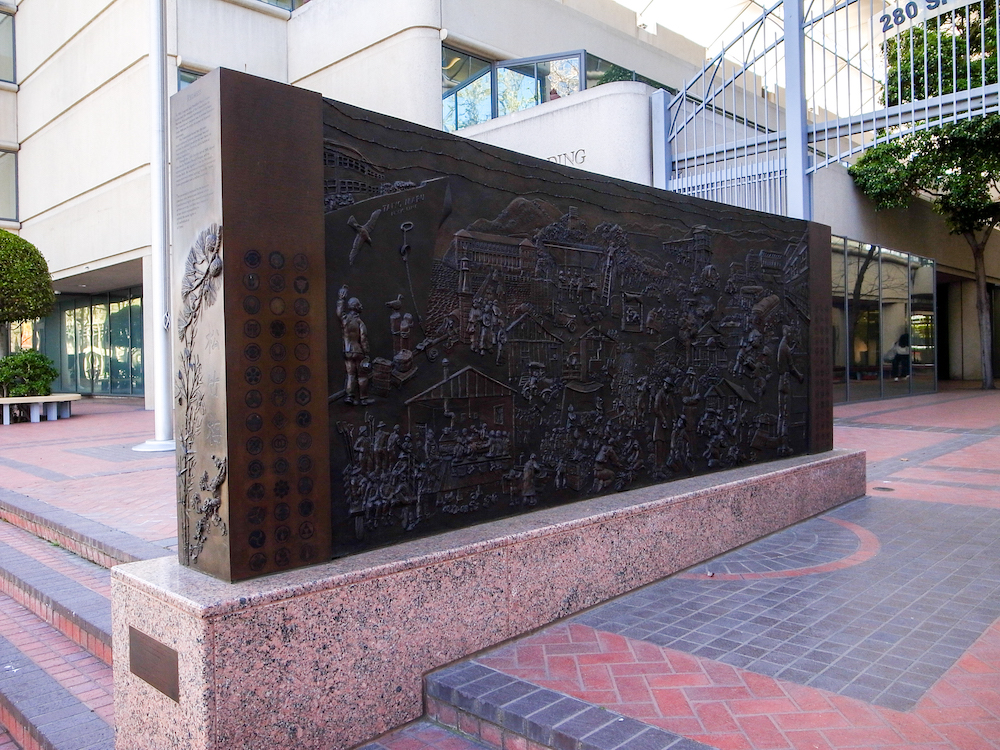Japanese-American Internment Memorial

Photographer: Hunter Ridenour (2022)
Artist: Ruth Asawa (@ruthasawaofficial)
Year: 1994
Commissioned by: City of San José Public Art Program
Artwork
Created by Japanese American modernist sculptor Ruth Asawa, this memorial, located outside of the Federal Building, commemorates the forced removal and incarceration of Japanese and Japanese-American residents of California during WWII.
Sculpted in bas-relief bronze, the memorial depicts key aspects of the Japanese American experience, before and after the WWII with a central focus on the experience of the incarcerated Japanese Americans during the war. The mural includes scenes of immigration, community life and agricultural labor and alongside symbols of the incarceration camps, including barracks, barbed wire, a watch tower, and heavily armed soldiers.
The whole is accompanied by text panels that include Executive Order no. 9066 by which relocation to internment was ordained, maps of internment camps, and other historical documents. A native Californian, Asawa herself, spent four years at an internment camp in Rohwer, Arkansas along with her family.
While the memorial symbolically commemorates the experience of all Japanese Americans, it has a special poignancy in San Jose, whose thriving Japanese and Japanese- American community experienced forced removal, incarceration and loss of property as a result of Executive Order no. 9066. Moreover, On May 24 and 25, 1942, San Jose State University served as a registration site for local residents of Japanese descent prior to their forced removal and incarceration. (See "SJSU Partners with Japantown Organizations to Recognize the 81st Anniversary of Executive Order 9066")
Public Art as Resistance
The “Japanese Internment Memorial” pushes the view to resist the urge to assign the injustices of the past to the yellowed pages of history. Memorializing the relocation and removal of Japanese Americans during World War II serves as an inflection point for considering the treatment of different groups today – where there is a failure to extend dignity, equality, and justice.
The placement of the memorial at the Federal Building recalls the actions of the United States government to act without dignity, equality, and justice and serves as a permanent protest against the violation of civil and human rights.
Art in Public Spaces
The five-story courthouse is part of the United States District Court’s Northern California district and whose branch serves Santa Clara, San Benito, Santa Cruz, and Monterey Counties. “The building is named after the late Judge Peckham, a former chief district judge of the Northern District who helped pioneer use of legal means other than court trials to resolve disputes. The Northern District’s Alternative Dispute Resolution program took root under his leadership and has since become one of the most innovative and successful in the nation”.1 The building itself was completed in 1984 and was designed by Hellmuth, Obata & Kassabaum (HOK), a global architectural, engineering, and planning firm. The facility consists of two low-rise steel-framed buildings with concrete exteriors connected by a canopy-covered courtyard.2 The canopy is constructed with a large crystal prism which refracts light and dispersed colors from our visible spectrum into the courthouse lobbies. According to a statement done by a former attorney who worked in the building in the 90s, the now-gated corridor used to be open to pedestrian foot traffic, but since 9/11, the fear of terrorism led to its enclosure shortly after.
There are also interesting signifiers that point to a possible situational dialogue between building and art piece; Federal Court having been established in 1984 and this piece was placed a decade later. The piece had already been there for seven years before the Federal Building put its gate up. “The crucial phenomenological point is that outsideness and insideness constitute a fundamental dialectic in human life and that, through varying combinations and intensities of outsideness and insideness, different places take on different identities for different individuals and groups, with human experience taking on different qualities of feeling, meaning, ambiance, and action”.3 The triangular relationship between the Courthouse, Ruth Asawa bronze sculpture, and San Jose State University, juxtapose potential conceptual and practical power of place, which according to Edward Relph, “gathers worlds spatially and environmentally, marking out centers of human action, intention, and meaning that in turn help make place”.4
From Contributor and Lead Tour Guide, Lou Jimenez, from her work for the course “Place and Placemaking” with Professor Gordon Douglas in the SJSU Department of Urban Planning (URBN 280) - (04/06/23)
Continue Your Walk
Make your way by the Plaza de Cesar Chavez, a few other works of public art, and The Tech Interactive to see our next interesting artwork located on Paseo de San Antonio, one of the most used passages in downtown.
Additional Resources
- Description by City of San Jose public art
- Fact sheet from San Jose cultural works
- Videos with the artist at work
- 6min discussion about her work, history, and the project itself (on her website)
- "Opinion: Chase: Asawa’s great work relevant to anti-Muslim bias today" SJ Mercury News (2016)
- Asawa Biography, San Jose Museum of Art
- "The Japanese-American Sculptor Who, Despite Persecution, Made Her Mark" New York Times Style Magazine (2020)
- "SJSU Partners with Japantown Organizations to Recognize the 81st Anniversary of Executive Order 9066"
- San Jose Nihonmachi Outreach Committee
- Center for Asian Pacific Islander Student Empowerment (CAPISE) @ SJSU
- “Hidden Histories” from Japanese American Museum of San Jose (video)
- "Japanese American Internment and the Men's Gymnasium" (Chp. 2 in Racial and Social Justice at San José State University)
Footnotes
1. “Robert F. Peckham Federal Building and U.S. Courthouse,” GSA, accessed July 6,
2022.
2. “Robert F. Peckham Federal Building and U.S. Courthouse,” GSA.
3. E. C. Relph, “Prospects for Places,” from his Place and Placelessness, in Larice
& MacDonald, eds., The Urban Design Reader: (1976).
4. E. C. Relph, “Prospects for Places,” from his Place and Placelessness.
Updated 4/6/23